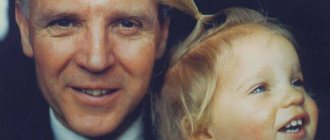Carl Gustav Jung can rightfully be called one of the most outstanding psychotherapists and psychologists of our time. Being a promising and promising student of Sigmund Freud himself, Jung was not afraid to challenge his teacher and move away from the classical theory of personality created by the famous Austrian psychologist. Thanks to the disagreements that arose between teacher and student in 1912, the world learned about Jung’s unusual and rather profound theory of personality.
In the personological tradition, Jung's theory of personality is the most complex, polemical and unorthodox. Unlike Sigmund Freud, whose theory of personality is based on aggression and repressed desires of a sexual nature, Carl Jung built his theory of personality on the basis of deep images or archetypes formed in the process of evolution.
Jung managed to create a unique, original theory of enormous scientific interest, which differs markedly from all other existing approaches to the detailed study of personality. In this article we will consider the main provisions of Carl Jung's theory of personality.
Introduction
At the turn of the 19th and 20th centuries in psychology, at that time still a very young scientific discipline, a bright and significant direction arose that continues to exist and develop to this day - psychoanalysis. The founder of psychoanalysis was the brilliant scientist, Austrian neurologist and psychiatrist Sigmund Freud (1856-1939). The fundamental difference between S. Freud’s theory and other areas of psychology of that time was the use of such an approach to the subject of science, in which the most important structural component of the psyche was its unconscious component (the unconscious, or “Id”). In other areas of psychology, the unconscious sphere of personality was not given much importance, or its existence was completely ignored.
S. Freud's psychoanalytic theory, striking in its depth, had a highly significant impact on the scientific community contemporary to its author and even on some aspects of the development of civilization, especially on art. Many followers of S. Freud appeared - adherents of the theory of psychoanalysis.
However, some students of the founder of this theory did not share his views in everything. The most talented of them include the Austrian ophthalmologist and psychiatrist Alfred Adler (1870-1937) and the Swiss psychiatrist Carl Gustav Jung (1875-1961). Inspired by the theory of S. Freud, these scientists, based on it, created their own directions of psychoanalysis: A. Adler called his theory individual psychology, C. G. Jung - analytical psychology.
Due to the fact that K. G. Jung was a highly educated person and had extensive knowledge in various fields of scientific knowledge [2, p. 59], the origins of analytical psychology lie not only in the psychoanalytic theory of S. Freud, but also in philosophy, mythology, and cultural studies and many others
This work is devoted to the study of analytical psychology by C. G. Jung.
Basics of teaching
The psychiatrist developed a personality structure according to Jung, which, in his opinion, consists of:
- Ego.
- Personal unconscious.
- Collective unconscious.
The ego is awareness and awareness, the inner “I”, as well as everything in the person himself that he is used to identifying and associating with himself.
Download for free: 5 books that will change your life! ♡
The personal unconscious is the experiences, thoughts and feelings that a person has chosen to repress from his brain. Also, the Personal Unconscious includes those experiences that have not yet reached consciousness, because they are not strong and formed enough, in addition, there are subliminal perceptions... In other words, this is everything that a person does not remember and is not aware of, nevertheless it has an impact on him and his actions.
archetypes
A brief summary of the fundamentals of his teaching will hardly help to understand the full scope of his work, but a short description will be useful to anyone interested in psychology.
We recommend: What is the unconscious?
The theory of archetypes is closely intertwined not so much with medicine, but with philosophy and esotericism, however, a person can find recognizable archetype images both in myths and legends, and in everyday life. Archetypes can be called innate mental structures that make up the content of the Collective unconscious.
Download for free: 5 books that will change your life! ♡
Jung, as a subtle connoisseur of the human soul, has always been attracted to man and his symbols, therefore the most famous archetypes are anima and animus - the feminine and masculine principles, respectively. Anima is an inward-directed soft power, the influence of emotions and moods. The animus, in turn, is a tough and principled masculine principle.
Other interesting archetypes that can be mentioned are: Virgo (Kora), Mana-personality, Sorcerous Demon and Beast. They are closely related to human character and quite accurately reflect some aspects of the human soul.
We recommend: Psychoanalysis is
Carl Gustav Jung also wrote and developed psychological types (psychotypes, in the lexicon of modern psychologists, or, more simply, personality types).
A person and his symbols in a dream are absolutely not random, since a dream is not just a set of colorful pictures reminiscent of worries experienced or a difficult day. Carl Jung created the theory of dreams, taking as a basis Freud's postulate that dreams reveal a person's secret thoughts, desires and feelings.
Download for free: 5 books that will change your life! ♡
The Swiss psychiatrist developed a set of universal images and scenarios that appear in dreams and allow them to be analyzed. Thanks to this unique technique, millions of people realized their fears and were able to get rid of them in a fairly short time.
Erica Berna
We recommend: Freudianism and neo-Freudianism
Carl Jung developed his own interesting typology, which turned out to be too complex, and therefore is known only in a narrow circle of professionals. He “brought to fruition” the typology, known since the time of Aristotle, contrasting introvert and extrovert, and enriched it with four more functions-signs. These functions:
- Thinking.
- Feeling.
- Feeling.
- Intuition.
There are many simplifications of Jung's classification of personality types; and the most famous simplified similarity to this typology is the now incredibly popular socionics.
Personality structure in the theory of C. G. Jung
Like S. Freud, C. G. Jung distinguished conscious and unconscious spheres in the structure of a person’s personality (soul). From the point of view of C. G. Jung, these spheres are essentially opposite to each other: “the unconscious, as Jung believes, is like the reflection of a mountain in a lake, a mirror image, the other side of the conscious... the unconscious is seen as performing a compensatory function” [2, p. 66 ].
The conscious sphere, according to C. G. Jung, includes conscious thoughts, feelings, memories and sensations and serves as the basis of self-awareness, allowing a person to perceive himself as a holistic and permanent personality [6, p. 200].
In the structure of the unconscious sphere of personality, C. G. Jung identified two separate but interacting components: the personal unconscious and the collective unconscious. The personal unconscious is a more superficial layer of the unconscious, the content of which is sensory complexes - “accumulations of emotionally charged thoughts, feelings and memories brought by the individual from his past personal experience” [6, p. 200]. Complexes, as a rule, are formed as a result of the influence of the repression mechanism - forgetting traumatic information.
The collective unconscious, from the point of view of C. G. Jung, is a deeper layer of the unconscious sphere of the individual, “which does not represent personal experience and is not acquired during life, but is innate” [7, p. 172]. The collective unconscious is genetically embedded in every person and “owes its existence exclusively to heredity” [1, p. 71].
The content of the collective unconscious is represented by archetypes. Archetypes are images of human memory, essentially similar to attitudes: they determine a person’s predisposition to certain reactions in certain conditions. At the same time, the archetype “begins to function everywhere where either conscious concepts do not yet exist, or where such, for internal or external reasons, are generally impossible” [9, p. 459], i.e. in cases where a person does not have the opportunity to focus on his own individual experience.
Thus, C. G. Jung’s point of view on the subject of personality structure can be presented in the form of the following diagram:
If C. G. Jung’s ideas about the conscious sphere of the individual and the personal unconscious largely coincide with the content of the theories of S. Freud and other supporters of psychoanalysis, then the concept of the collective unconscious is a feature of analytical psychology.
C. G. Jung came to the conclusion about the existence of archetypes based on an analysis of significant similarities between the images he repeatedly observed in the descriptions of fantasies, dreams, delusions and obsessions of his patients, with images contained in myths and fairy tales of many cultures. C. G. Jung believed that such similarities are due to their common nature: “the reduced activity of consciousness and lack of concentration of attention, abaissement du niveau mental [1], correspond quite accurately to the primitive state of consciousness in which, presumably, myths were originally formed. Therefore, it seems extremely likely to us that mythological archetypes arose in much the same way as today’s manifestations of archetypal structures in individuals” [8, p. 91].
The functional meaning of archetypes, according to K. G. Jung, lies, on the one hand, in the transmission of significant information about environmental objects and their properties from generation to generation and, thus, contributes to the adaptation of individuals to environmental conditions. On the other hand, archetypes can serve as psychological protection: “religious myths can be interpreted as a kind of mental therapy against the suffering and unrest of all humanity - hunger, wars, disease, old age, death. The world-wide myth about the hero, for example, always describes a powerful man or god-man who defeats evil in all its manifestations in the form of dragons, snakes, monsters, demons, etc., and saves people from destruction and death" [11, p. 88 -89].
The main examples of archetypes described by C. G. Jung are [6, p. 201]:
- Anima is the unconscious feminine side of a man’s personality;
- Animus is the unconscious male side of a woman’s personality;
- God is the ultimate realization of psychic reality, projected onto the external world;
- The sage is the personification of life’s wisdom and maturity;
- Persona is a “public face”, a person’s social role that stems from social expectations and early learning;
- The Self is the embodiment of the integrity and harmony of the individual;
- The shadow is the socially unacceptable unconscious opposite of what the individual persistently affirms in consciousness.
Thus, the most important scientific discovery of C. G. Jung in the field of studying the psychological structure of personality is the idea of the existence of a collective unconscious common to all people - a repository of the memory of humanity, and archetypes - images that make up its content.
Conclusion
Knowing the basic concepts of personality development, you can significantly influence the process of its formation. This knowledge is indispensable when raising children, as well as for working on oneself and drawing up a plan for personal development. Creating a favorable environment for personal growth requires certain efforts, as well as spiritual, time, and monetary costs. Such expenses are necessary in order for the child’s positive qualities to develop and the motivation for activity to increase. But popular wisdom says: “trees grow on stones.” Even if there are environmental factors and one must remember the proverb - heredity is far from ideal, a person has a chance to improve his life and increase even the small potential that he has.
Topic: Personal growth
Personality typology K.G. cabin boy
Another important discovery of C. G. Jung in the field of personality psychology is the classification he developed of the so-called ego-orientation and description of the characteristics of extroverted and introverted personality types.
C. G. Jung came to the idea of the existence of two fundamentally different personality types based on an analysis of his own twenty years of experience working with patients. He noticed that the functioning of the mental sphere of some people is focused primarily on the object - external conditions, while the source of the mental activity of other people is the subject - internal factors.
C. G. Jung called the phenomenon of mental activity turning to the external environment extraversion: “if orientation by the object and by the objectively given predominates so much that most often the most important decisions and actions are determined not by subjective views, but by objective circumstances, then we are talking about an extroverted attitude ... If a person thinks, feels and acts, in a word, lives in a way that directly corresponds to objective conditions and their requirements, both in a good and in a bad sense, then he is extroverted. He lives in such a way that the object, as a determining quantity, obviously plays a more important role in his consciousness than his subjective view... His entire consciousness looks into the external world, for an important and determining decision always comes to him from the outside” [9, p. 406-407].
The opposite phenomenon - the reversal of mental activity on the inner world of a person - was given the name introversion by C. G. Jung: “the introverted type differs from the extroverted one in that it is focused primarily not on the object and not on objective data, like the extroverted one, but on subjective factors... introverted consciousness sees external conditions and nevertheless chooses the subjective determinant as decisive” [9, p. 455].
Analyzing the functional meaning of extraversion and introversion, C. G. Jung drew an analogy between the psychological characteristics of these types and the characteristics of two types of biological adaptation of the human body to the environment. “Nature knows two fundamentally different adaptation options and two, resulting from them, possibilities for self-sustainment of living organisms,” writes K. G. Jung, “the first path is increased fertility with relatively low defense capacity and fragility of the individual; the second way is to equip the individual with various means of self-preservation with relatively low fertility. It seems to me that this biological opposition is not only an analogy, but also the common basis of our two psychological modes of adaptation. Here I would like to limit myself to just one general indication, on the one hand, of the peculiarity of the extrovert, which consists in the ability to constantly waste, spread and penetrate into everything; on the other hand, the introvert’s tendency to defend himself from external demands and, as far as possible, to refrain from any expenditure of energy directed directly at the object, but to create for himself the most secure and powerful position possible” [9, p. 404].
The author of these concepts believed that each person simultaneously has both mechanisms, extraversion and introversion, and belonging to a certain personality type is determined only by the predominance of one or the other.
In developing a personality typology, C. G. Jung did not limit himself to classifying people according to their ego orientation. Also based on his own many years of experience, he discovered that “Consciousness orients itself in the environment in the following four functional ways: through sensation (that is, perception by the senses), indicating the presence of something; reflection explaining to us what it is; a feeling that tells us whether it is pleasant or not, and an intuition that tells us where it comes from and where it is going” [11, p. 56]. Sensation, thinking, feeling and intuition were called mental functions by C. G. Jung. All these functions are present in every person, but one of them, as a rule, dominates over the others. Therefore, both extroverted and introverted personality types, depending on the predominance of the value of one or another mental function, can also be thinking, feeling, sensing or intuitive.
Developing the theory of mental functions, C. G. Jung classified thinking and feeling as rational functions, sensation and intuition as irrational. The difference between rational and irrational functions is that if the former “base their entire course of action on the judgment of the mind,” then the latter “on the absolute power of perception” [9, p. 452].
Thus, C. G. Jung’s personality typology is built on two bases: the predominant ego orientation (extroversion or introversion) and the leading mental function (thinking, feeling, sensing or intuition). The interaction of both forms the eight main types of human personality: extroverted thinking, extroverted feeling, extroverted feeling, extraverted intuitive, introverted thinking, introverted feeling, introverted feeling and introverted thinking.
Archetype
Jung himself explained the term “archetype” as follows: these are transcendental (that is, unknowable, not fully studied) reality in relation to consciousness, bringing to life whole complexes of various kinds of ideas that appear in the form of mythological motifs.
Archetypes appear in human consciousness, but we cannot catch them, since they are invisible and cannot be detected. But they exist and we can observe their action in our lives.
Jung himself gives the following example to explain this mysterious phenomenon. Imagine a crystal growing in a special solution. We definitely know for sure that it develops along very specific geometric axes. The crystal grows according to a strict pattern; it does not do it arbitrarily, it has a given direction. But these axes themselves are not visible in space before the branches are finally formed. We do not detect them: they are not in the stone or in this solution. And only by the way the crystal grows, its bizarre, but always very harmonious and consistent branches, can we trace the history of these axes that are not actually visible. Likewise, archetypes, according to Jung, also cannot be detected, but in any case they form, determine our consciousness, influence it with various kinds of symbols, of which there can be an unlimited number.
Jung spent his entire life trying to understand the phenomenon of these images. He believed that the main task of psychology was to interpret the archetypes that arose in patients.
Representations by K.G. Jung on personality development
C. G. Jung attached great importance to issues of personality development in his theory. The peculiarities of his views on personality development are associated with the concepts of “self” and “individuation”.
As already mentioned (see point 1), the self is the archetype of mental integrity and unity of personality. However, the self acts not only as an archetype, but also as the ultimate goal of personality development. The archetypal features of selfhood are associated with the fact that, firstly, its final achievement is empirically impossible (hence, the development of personality essentially has no limit), and secondly, the desire for intrapersonal harmony is characteristic of almost all people without exception, which determined the consolidation of selfhood as one of the leading symbols in the collective unconscious. The very concept of “personality” in connection with the achievement of selfhood was defined by C. G. Jung as “a definite, capable of resistance and endowed with strength mental integrity” [10, p. 68].
K. G. Jung understood individual and social as phenomena interconnected by inverse proportionality: the more social, the less individual, and vice versa. Therefore, the achievement of selfhood, according to C. G. Jung, can only be achieved through individuation - to the detriment of the social. Individuation is a process of differentiation, separation of the individual from the social and “formation... of the psychological individual as a being different from the general, collective psychology” [9, p. 536]. The ultimate goal of individuation is also the development of personality. In connection with the implementation of the process of individuation, C. G. Jung also defined the concept of “personality” as “the highest realization of the innate originality of an individual living being” [10, p. 70].
At the same time, individuation does not necessarily mean that the individual comes into conflict with social norms: “Individuation under no circumstances can be the only goal of psychological education. Before making a goal out of individuation, it is necessary to achieve another goal of education, namely, adaptation to the minimum of collective norms necessary for existence: a plant intended for the fullest development of its abilities must first of all be able to grow in the soil in which it is planted "[9, p. 538].
Since personality development is associated with individuation, it inevitably requires significant psychological effort and expense: “personal development from initial inclinations to full consciousness is charisma and at the same time a curse: the first consequence of this development is the conscious and inevitable isolation of an individual being from the indistinguishability and unconsciousness of the herd. This is loneliness, and nothing comforting can be said about this. No successful adaptation and no unhindered adaptation to the existing environment, nor family, society, or position will get rid of this” [10, p. 72].
The presence of a large number of difficulties encountered on the path of personality development leads to the fact that not every person becomes an individual: “The fact that conventions of some kind invariably flourish proves that the overwhelming majority of people choose not their own path, but the conventions and as a result, each of them develops not himself, but some method, and therefore something collective at the expense of his own integrity” [10, p. 73].
Personal development, according to C. G. Jung, can continue throughout a person’s life.
Thus, the development of personality, from the point of view of C. G. Jung, is carried out in the direction of achieving selfhood (personal integrity and harmony) through individuation (separation of the individual from society).
Basic provisions of the Makarenko system
Many teachers, seeing children marching in formation, fell into horror. Makarenko’s personal development program gave brilliant results - but, as they believed, “the methods were not right.” The main idea of the teacher was the following: children can and should work. But now the time of child labor is prohibited. In fact, the Makarenko system is implemented only in some private enterprises.
Makarenko’s personal development program was based on discipline, which, at the same time, was not a method of education. Rather, order was its result. For the teacher, education was not a reading of morality - it was strictly established orders, the organization of the life of the colonists. The interests of the individual were always subordinated to the interests of the collective if the individual opposed public opinion. At the same time, Makarenko advocated democratic relations in the team and the possibility of creative self-expression. The teacher created all the conditions to ensure that the psychological climate in the colony was favorable. One of the main means of education was a mandatory regime for everyone. The regime must be precise and expedient.
Makarenko’s works were greatly influenced by the works of M. Gorky. The writer is known for having an optimistic approach to human nature, believing in his strength, and this is reflected in Makarenko’s concept of personality development. The teacher believed that the responsibility that a teacher bears is worth learning from Gorky. After all, the writer, having the ability to see the best in a person, was never moved by these traits and did not lower the bar of requirements.
The main differences between the personality theories of S. Freud and C. G. Jung
As already noted (see Introduction), C. G. Jung’s analytical psychology arose primarily on the basis of the psychoanalytic theory of S. Freud, but is a separate direction due to the presence of some significant differences from psychoanalysis. It is known that S. Freud and C. G. Jung “worked in close collaboration for many years. As Freud believed, Jung was to become his successor and serve in the Vienna Psychoanalytic Society" [4, p. 189]. However, in 1913, there was a break in relations between them, “due to which Freud, as is well known, lost consciousness twice” [4, p. 189], and C. G. Jung experienced a severe mental crisis for four years [6 , page 198]. Nevertheless, “their names were so closely connected that when Jung, when asked by the curator of the British Museum to name his last name, said “Jung,” he asked again: “Freud-Jung-Adler?” and heard an apology in response: “No, only Jung” [5, p. 157].
In this regard, it is advisable to analyze the differences between the personality theories of S. Freud and C. G. Jung. The most common point of view regarding the source of the differences in the views of S. Freud and C. G. Jung is the assumption that C. G. Jung did not share the so-called increased attention of S. Freud to sexuality [6, pp. 197-198]. However, upon careful examination of at least the correspondence between S. Freud and C. G. Jung, it turns out that this point of view is apparently due to a misunderstanding of the essence of S. Freud’s theory. Thus, in one of his letters to S. Freud, C. G. Jung writes: “the expression “libido”, in general all terms transferred from sexuality to a sphere that is too broadly understood by you (which, no doubt, has its justification), allow for false interpretations and, at the very least, unsuitable from a didactic point of view. They immediately cause a defensive emotional reaction, which leads to discrediting the entire therapy” [From Jung’s letter to Freud dated March 31, 1907; 3, p. 374]. In turn, S. Freud repeatedly mentions his discussions with opponents of such terminology: “they attacked me, demanding that I replace the concept of “sexuality” with another word ... then all objections and misunderstandings will disappear by themselves. I replied that I did not believe in the success of such an enterprise; by the way, they were never able to offer me another term” [From Freud’s letter to Jung dated 10/15/1908; 3, p. 396]. Thus, the opinion that S. Freud exaggerated the importance of sexuality was apparently caused only by shortcomings in terminology, which led to difficulties in understanding psychoanalysis.
As evidenced by the analysis of the correspondence, S. Freud treated the alternative concepts of his followers quite adequately. For example, his reaction to one of the theoretical disagreements with C. G. Jung were the following lines: “The nature of your innovation is not very clear to me yet... As soon as I have enough information, I will certainly be able to understand everything objectively, if only because I am aware of my bias” [From Freud’s letter to Jung dated June 13, 1912; 3, p.450]. Apparently, the break in the relationship between S. Freud and C. G. Jung was largely due to personal factors. Thus, in one of his last letters, K. G. Jung openly stated: “I want to draw your attention to the fact that your technique of dealing with your students is erroneous... You reduce your surroundings to the level of sons and daughters who, blushing, confess to you having vicious tendencies. And every time you proudly rise above them in the role of a father” [From Jung’s letter to Freud dated 12/18/1912; 3, pp.461-462].
Returning to the differences between the personality theories of S. Freud and C. G. Jung, the following main aspects should be noted:
- Personality structure. The concept of “personal unconscious” in the analytical psychology of C. G. Jung is generally similar to the concept of “Id” in the psychoanalysis of S. Freud; There are also no significant differences in the understanding of the conscious sphere of personality between these theories. The difference in the ideas of both authors about the structure of personality lies in the fact that if Z. Freud identified the “Super-Ego” as the third component of personality, then C. G. Jung identified the “collective unconscious.” The super-ego in psychoanalysis is the result of the assimilation in childhood of social norms and rules of behavior, i.e. a system of moral prohibitions and ideals acquired in the process of socialization (mainly education). The similarities between the Super-Ego and the collective unconscious, first of all, include their social basis, the differences include the acquired character of the Super-Ego and the innate character of the collective unconscious.
- Typology and personality development. According to the psychoanalytic theory of S. Freud, a person’s personality in childhood in its development, based on the dynamics of the dominance of erogenous zones, goes through several stages (oral, anal, phallic, latent and genital). In cases where at any stage the child receives excessive or insufficient stimulation of the dominant erogenous zone, one or another type of personality is formed; a mature personality is formed only if it adequately goes through all stages. At the same time, the foundation of personality is laid by the age of 5-6 years. Thus, S. Freud emphasized the biological aspect of personality development, which, in turn, is the basis for personality typology. K. G. Jung, as already noted (see paragraphs 2 and 3), in the problem of personality typology, focused on ego-orientation and mental functions, and in the problem of personality development - mainly on the individual aspect and on the relationship between the individual and the social. Therefore, the ideas of S. Freud and C. G. Jung on the subject of typology and personality development essentially do not coincide, but they do not intersect, and therefore are not mutually exclusive.
Thus, the main differences between the theories of S. Freud and C. G. Jung come down, firstly, to the differences between the “Super-Ego” in psychoanalysis and the “collective unconscious” in analytical psychology, and secondly, to the presentation of C.G. Jung on the continuation of personality development throughout life, as opposed to S. Freud’s idea that the fundamental component of personality is laid down in early childhood.
Departure from classical psychoanalysis
In 1914, a break occurred between Freud and Jung. And although in general, Jung remains in the position of psychoanalysis, his views on one of Freud’s most basic provisions - on the dominant role of sexual drives in the motivation of the human personality - diverge significantly from the views of his teacher, which leads to irreconcilable contradictions.
There were two reasons for the fundamental divergence: Jung’s own approach to the ideas of libido and the unconscious.
Bibliography
- Analytical psychology: Past and present / K. G. Jung, E. Samuels, V Odaynik, J. Hubback; Comp. V.V.Zelensky, A.M.Rutkevich. – M.: “Martis”, 1995. – 320 p. – (Series “Classics of Foreign Psychology”).
- Brown J. Freudian psychology and post-Freudians. – M.: “Refl-book”, 1997. – 298 p. – (Series “Current Psychology”).
- Sigmund Freud – Carl Gustav Jung. From correspondence / Freud Z. Beyond the pleasure principle. M.: “Litera”, 1992. – p. 364-467.
- Kutter P. Modern psychoanalysis. Introduction to the psychology of unconscious processes. – St. Petersburg: “B.S.K.”, 1997. – 324 p.
- Petrovsky A.V., Yaroshevsky M.G. History and theory of psychology. - In 2 volumes. – Volume 1. – Rostov-on-Don: “Phoenix”, 1996. – 416 p.
- Kjell L., Ziegler D. Theories of personality. – 3rd ed. – St. Petersburg: Peter, 2005. – 607 p. – (Series “Masters of Psychology”).
- Jung K.G. Alchemy of dreams. Four archetypes. – M.: “Semira”, 1995. – 350 p.
- Jung K.G. Soul and myth. Six archetypes. – Kyiv: “State Library of Ukraine for Youth”, 1996. – 384 p.
- Jung K.G. Psychological types. – M.: “AST”, 1998. – 720 p. – (University Book Series).
- Jung K.G. Formation of personality / Psychology of personality in the works of foreign psychologists / Comp. and general editing by A.A. Reana - St. Petersburg: Peter Publishing House, 2000. - p. 65-79. – (Series “Anthology on Psychology”).
- Jung K.G. Man and his symbols. – St. Petersburg: “B.S.K.”, 1996. – 454 p.
[1] Decrease in mental level (lat.)
1.doc
ABSTRACT
personality unconscious literature
Introduction
Carl Gustav Junglection
^ A. Adler, K. Horney E. Fromm transformation. analytical psychology
Analytical psychology
^ 1. The structure of the human psyche in the concept of K.G. Jung of the collective unconscious, individual unconscious (It) consciousness (Ego). creative reasonable principle ^ 1.1. The structure of the conscious and unconscious in the human psyche human consciousness components perception
Perception
something than thinking emotional assessments intuitive anticipations of the will of drives Dreams the unconscious part of the psyche complexes Complexes archetypes . psychoids collective unconscious ^ 1.2. Collective unconscious and archetypes Collective unconscious of archetypes Archetypes , archetypal image Ego Persona Shadow technique of handling the Shadow) Anima Animus Self , the most important archetype development of the Self is the main goal of human life. individuation four systems of the psyche ^ Ich Persona Schatten Anima Animus Finding the Self ^ Concept of K.G. cabin boy
| Understanding Personality | Personality (human soul) consists of three interacting structures: consciousness (Ego), individual unconscious and collective unconscious. Personality development is a dynamic process, evolution throughout life as a result of the desire of various components of the personality for unity, integration, harmony, integrity, and the acquisition of Self. Individuation is the development of personality, a dynamic process of integration of many opposing forces and tendencies within the personality, resulting in the full development and expression of all elements of personality - self-realization. |
| Attitude to the body | The body is not an independent principle, but an expression of mental experiences, i.e. the physical and spiritual are in unity. The significance of bodily experiences fully corresponds to how they are represented in the psyche. |
| Social relations | Social relationships are material for filling out archetypes. The shape of this material is given by archetypes, i.e. social relations are not dominant. Personal development is individuation, i.e. the path to the Self, but at the same time it is associated with a deepening into the collective unconscious. |
| Will | Manifestation of volitional energy as an introduction to culture. The will can influence the unconscious, although not directly. |
| Emotions | The significance of emotions is determined by their connection with archetypes. Emotions are a manifestation of the unconscious. This is a kind of mediator between the psyche and physical life. They act as an energetic force that allows us to determine the success of the individuation process. Strong emotions are the source of personality development. |
| Intelligence | Intelligence is a conscious function, so it has limitations. Intellectual explanations can never be complete. Intelligence is complemented by intuition (the intuitive function is based on unconscious material). |
| Self | The self is the central formation in the human psyche. This is a dynamic balance of mutually exclusive forces: extra- and introversion, conscious and unconscious; masculine and feminine principles. Such balance presupposes the completeness of experiences of one’s unconscious. The path to the Self is never completed, since personality is not subject to description or full awareness. Development of the Self is the main goal of human life |
| Attitude towards psychotherapeutic assistance | Jungian psychotherapy is one of the most popular in the world. It involves two stages: 1. The analytical phase includes two phases: the initial phase - recognition of the analyzed material; the second - interpretation, interpretation of the material (the patient depends on the therapist). 2. Synthetic (the patient becomes independent from the therapist) includes: a learning phase (material from the past is applied to today); a transformation phase - mini-individuation (a new understanding of the problems of one’s personality is achieved). |
^ 2. Personality typology of extroverts and introverts .
Jung's typology Conclusion References
^






